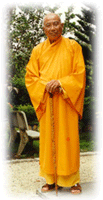 Vietnamese Zen Buddhism is composed of three important meditation practices of Zen Buddhism from China to Vietnam – the Second Patriarch Dazu Huike, the Sixth Patriarch Dajian Huineng, and the Truc Lam Zen (Bamboo Grove). Zen Master Venerable Thich Thanh Tu integrated the awakening, the enlightenment and the practices of the three Patriarchs into the meditation method and revived the Vietnamese Zen Buddhism.
Vietnamese Zen Buddhism is composed of three important meditation practices of Zen Buddhism from China to Vietnam – the Second Patriarch Dazu Huike, the Sixth Patriarch Dajian Huineng, and the Truc Lam Zen (Bamboo Grove). Zen Master Venerable Thich Thanh Tu integrated the awakening, the enlightenment and the practices of the three Patriarchs into the meditation method and revived the Vietnamese Zen Buddhism.
The Second Patriarch Dazu Huike
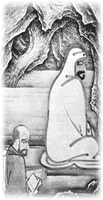 After being accepted as a disciple of Bodhidharma, Huike’s mind still wandered when meditating. One day, he asked Bodhidharma: “Venerable Master, my mind is not at peace, please teach me a Dharma to pacify it.” Bodhidharma replied “Bring me your mind, I’ll pacify it.” Huike looked for his mind but found no sign. He then said “I can’t find it.” Bodhidharma replied “I have pacified your mind.” At that moment, Huike knew the way in.
After being accepted as a disciple of Bodhidharma, Huike’s mind still wandered when meditating. One day, he asked Bodhidharma: “Venerable Master, my mind is not at peace, please teach me a Dharma to pacify it.” Bodhidharma replied “Bring me your mind, I’ll pacify it.” Huike looked for his mind but found no sign. He then said “I can’t find it.” Bodhidharma replied “I have pacified your mind.” At that moment, Huike knew the way in.
Huike got enlightened without any Dharma. We all believe that our restless thoughts are our mind, and so did Huike. We feel miserable when our mind are filled with a never-ending train of thoughts during sitting meditation. Searching for a way to find peace of mind is essential for those who are determined to achieve enlightenment. Bodhidharma did not teach Huike any Dharma, instead he said “Bring me your mind, I’ll pacify it.” His saying was like a thunder dispelling Huike’s ignorance.
We are usually being manipulated by our inner chatter, but when we want to find it, we can’t. When thoughts no longer exist, aren’t we at peace? That’s why Bodhidharma said “I have pacified your mind.” Huike wisely realized it and became enlightened. Did Bodhidharma show him any methods to soothe his mind? If not, how did Huike apprehend it? Clearly, there was no Dharma to soothe his mind, but when he shone the light of wisdom to his restless mind, it vanished. In Zen terms, it is called “looking inward”. We call it “aware of false thoughts and not to follow them”. This is Huike’s “knowing the way in”.
When we are thinking, we know we are thinking. When we are not thinking we know we are not thinking. Thoughts are merely objects being observed by us. If thoughts are being watched, then they are our guest, they are not us. If the thinking were us, then when we didn’t think, how would we know we were not thinking? It doesn’t make sense to accept thoughts are us when we are the ones watching them drifting.
The Buddhist scripture describes the way of identifying with thoughts as “mistakenly thinking the enemy as your child” which leads to an unpredictable disaster. Throughout scriptures and practice methods, the Buddha’s teachings revolved around the principle of “disidentifying from the wandering mind”. Chanting with focus, reciting with sincere faith, and meditation with mindfulness … In Zen Buddhism, the Patriarchs did not use means to crush the distracted mind, but rather used wisdom to see the unreal nature of thoughts and to achieve calmness and insight. Bodhidharma’s phrase “Bring me your mind, I’ll pacify it” summarized perfectly the above process.
The Sixth Patriarch Dajian Huineng
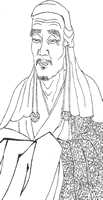 The Sixth Patriarch Huineng attained enlightenment upon listening to the Diamond Sutra. In the Fifth Patriarch Daman Hongren’s hut, when he heard the Venerable Subhuti asked the Buddha in the Diamond Sutra “World-Honoured One, if one wants to achieve the Supreme Enlightenment, how would one master their mind?” The Buddha replied “One should not rely on form, sound, smell, taste, touch, or object of mind. They should not allow their mind to arise dwelling anything.” Huineng exclaimed “Indeed one’s Buddha nature is fundamentally pure. One’s true nature is eternal. One’s nature is innate in each of us. One’s true mind is not abide to external conditions. One’s true nature manifests.” He was then given the robe and bowl by the Fifth Patriarch and became the Sixth Patriarch.
The Sixth Patriarch Huineng attained enlightenment upon listening to the Diamond Sutra. In the Fifth Patriarch Daman Hongren’s hut, when he heard the Venerable Subhuti asked the Buddha in the Diamond Sutra “World-Honoured One, if one wants to achieve the Supreme Enlightenment, how would one master their mind?” The Buddha replied “One should not rely on form, sound, smell, taste, touch, or object of mind. They should not allow their mind to arise dwelling anything.” Huineng exclaimed “Indeed one’s Buddha nature is fundamentally pure. One’s true nature is eternal. One’s nature is innate in each of us. One’s true mind is not abide to external conditions. One’s true nature manifests.” He was then given the robe and bowl by the Fifth Patriarch and became the Sixth Patriarch.
Through the enlightenment story of the Sixth Patriarch, we can relate to the Prajna sutra which says that the detachment of the six sense bases from the six sense objects will lead us to the Supreme Enlightenment. The Sixth Patriarch did not stop at the non-attachment but leaped into the Buddha nature which exists within all sentient beings. Enlightenment is when one realizes one’s own true nature and is able to execute it in every moment.
When the mind remains calm while confronting the external world, that state of mind is called non-conceptual or “no-thought”. Detachment from the Dharma and from worldly objects and concerns was the Sixth Patriarch’s principle of teaching. Zen Buddhism does not encourage practitioners to run way from the surrounding world but rather trains their mind to not get affected when coming into contact with the six sense objects.
The Truc Lam Patriarch
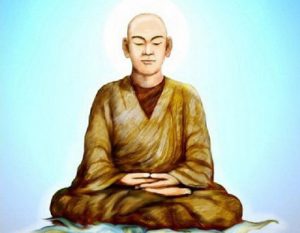 King Tran Nhan Tong mastered Zen Buddhism thanks to the education of his royal general and teacher, Tue Trung Thuong Si, when he was the Crown Prince. After passing the throne to his son to become a Buddhist monk, he called himself Huong Van Dai Dau Da and founded Bamboo Grove School, known as Vietnamese Zen Buddhsim. He integrated the sects of Zen Buddhism from Vinitaruci (India), Wu Yangtong (China) and Tsao T’ang (Champa) and travelled across the nation to spread the teachings.
King Tran Nhan Tong mastered Zen Buddhism thanks to the education of his royal general and teacher, Tue Trung Thuong Si, when he was the Crown Prince. After passing the throne to his son to become a Buddhist monk, he called himself Huong Van Dai Dau Da and founded Bamboo Grove School, known as Vietnamese Zen Buddhsim. He integrated the sects of Zen Buddhism from Vinitaruci (India), Wu Yangtong (China) and Tsao T’ang (Champa) and travelled across the nation to spread the teachings.
He opposed dualism – right and wrong, good and bad, win and loss, and etc. They are the cause of struggle, affliction and suffering for not knowing the ultimate truth. Overcoming duality is the basis of Zen Buddhism and also the essence of Buddhism.
Tran Nhan Tong composed “Contentment With Life” poem:
In life, be content with the way of being
Let’s eat when hungry and sleep when tired.
Treasure is within, let’s cease seeking
Live life unattached, need not to inquire Zen.
“Treasure is within” reflects what the Sixth Patriarch uttered “No wonder our own nature is pure!” Meditation means arise to no-thought when dealing with daily activities. No-dwelling is when the mind does not cling to sense objects. The last line of the verse covers no-thought, no-form, and no-dwelling which was exactly what the Sixth Patriarch emphasized. The Truc Lam Patriarch skillfully applied both the realization of the Second Patriarch and the practice of the Sixth Patriarch. As their successors, we are proud to have the Zen sect that carries on the practicing methods of the patriarchs and of our ancestors in Vietnam.
Integration of The Meditation Practices
We integrated meditation principles of the three patriarchs above into a specific practice as follows.
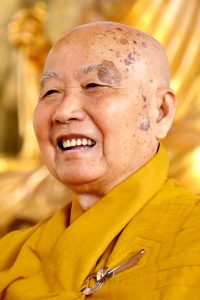 Zen Master Venerable Thich Thanh Tu applied the mind-pacifying from the Second Patriarch Huike. Knowing that thoughts are illusory, we do not allow them deceive us or take control over us. We called it “aware of the false thoughts and not attach to them”. When the practitioners aware of a thought every time it arises and understand its illusory nature, then thought disappears on its own. This is done not only during sitting meditation but also at every moment of the day. The end result is as the Second Patriarch said “End of all distractions and clinging to the external world but still aware of the surrounding. This can’t be expressed in any words.”
Zen Master Venerable Thich Thanh Tu applied the mind-pacifying from the Second Patriarch Huike. Knowing that thoughts are illusory, we do not allow them deceive us or take control over us. We called it “aware of the false thoughts and not attach to them”. When the practitioners aware of a thought every time it arises and understand its illusory nature, then thought disappears on its own. This is done not only during sitting meditation but also at every moment of the day. The end result is as the Second Patriarch said “End of all distractions and clinging to the external world but still aware of the surrounding. This can’t be expressed in any words.”
However, it is not easy to turn off the mind from thinking or getting distracted. Practitioners need to patiently witness the thoughts but do not engage in thinking, then gradually fewer and fewer thoughts will come. Accepting the illusion in your mind is deluded, knowing that false thoughts are not real means awakening. This way of practice uses wisdom to break delusion without using anything to crush the thought. That is pacifying mind without a Dharma. When false thoughts have ceased, the wisdom no longer exists as being described in the Ten Ox Herding pictures. Both the ox and the shepherd transcended. Nothingness.
From the Sixth Patriarch, Master Thich Thanh Tu applied the non-attachment of the six sense bases (eye, ear, nose, tongue, body and mind) to the six external sense objects (form, sound, smell, taste, touch, and thoughts) as the direction of cultivation. The Fifth Patriarch quoted “One should give rise to the mind that is not dwelling anything” from Diamond Sutra when he trained the Sixth Patriarch. But how can we not react to what happens around us? We must use Prajna wisdom to see the nature of reality and the interconnectedness of all things and to realize the impermanence and the non-existence of the self. The state when the mind is not clinging to whatever life presents us is the state of no-thought, no-form, and no-dwelling, and that is the Sixth Patriarch’s principle practice.
Another way of practice is if the practitioners who can live with the eternal true nature like the Sixth Patriarch, then they are not consumed by illusions but rather walk, stand, lie and sit with their Buddha nature. The practitioners “eat when hungry and drink when thirsty” at ease.
In the stanza “Perceiving The Existence and Void”, the Truc Lam First Patriarch wrote “Like snow hat and floral shoes. Clinging to a tree, awaiting the rabbits” which reveals the Prajna spirit of the Six Patriarch. The Dharmas are like hats made of snow, like shoes made of flowers. Things temporarily exist then cease. Nothing lasts forever. We are a fool like the person waiting at the tree to catch a rabbit if we hold on to the past or get stuck in emotion. The same applies to the Dharmas. They help us to cross over to the shore of liberation, but they are not for us to grasp. The raft is no longer needed when we get on the shore. When thoughts arise, judgment comes along and words are said. When we let go of the right and wrong, there will be no thoughts to emerge or words to say. This is a true living with meditation.
The two verses “Treasure is within, let’s cease seeking. Live life unattached, need not to inquire Zen.” portray the same attainment that the Sixth Patriarch once exclaimed “Indeed one’s Buddha nature is fundamentally pure.” Knowing the priceless gem are within us, there is no need to look elsewhere. Seeing that our own nature is pure, neither born nor died, compared to the temporary body and the illusory mind, we will neither attach to the body nor cling to the idea of the self, resulting no affection and no dwelling. This is the basis of Zen as well as the rudiment of Buddhism. “Live life unattached, need not to inquire Zen” is our practicing principle. No thought means the absence of discursive and unwholesome thought when dealing all aspects of life. It doesn’t turn practitioners into non-sentient beings like stone or woods. Constantly living with the true mind is the door for Buddhist practitioners to liberate from the cycles of birth and death.
Historically, Bodhidharma introduced four Sutras to the Second Patriarch Huike after his enlightenment. The Sixth Patriarch Huineng attained enlightenment from listening to the Diamond Sutra. It demonstrates that Zen Buddhism does not stay away from the scriptures because Zen is the mind of the Buddha and scriptures are the words of the Buddha. The Buddha’s mind and his words are inseparable, so are Zen and the Dharma. That’s why we advocate “concurrency of meditation and studying sutras”.
Below is the summary of our practice.
1. Aware of false thoughts and not attach to them, because false thoughts are illusionary.
2. Dealing with all matters with a no-thought mind, because everything changes and nothing stays the same forever.
3. Don’t fall into either side of duality, because it is not real.
4. Constantly live with the true mind, because the true mind leads to liberation while the chattering mind is the cause of reincarnation.
Source: Book “Thiền Tông Việt Nam Cuối Thế Kỷ 20”
http://www.thientongvietnam.net/gioithieuTTVN/index.html
Translated by: Trang (Nguyen Nghiem)
